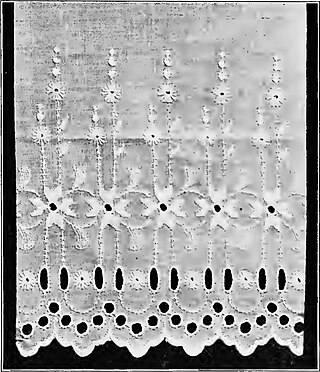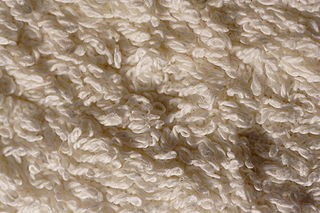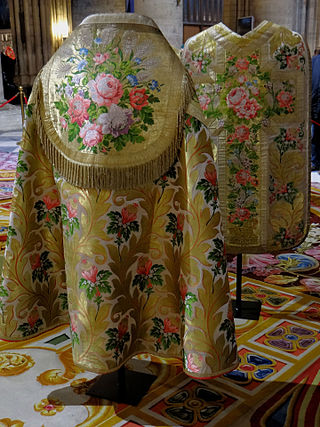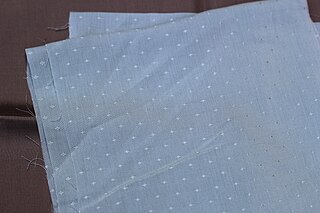Related Research Articles

Calico is a heavy plain-woven textile made from unbleached, and often not fully processed, cotton. It may also contain unseparated husk parts. The fabric is far coarser than muslin, but less coarse and thick than canvas or denim. However, it is still very cheap owing to its unfinished and undyed appearance.

Weaving is a method of textile production in which two distinct sets of yarns or threads are interlaced at right angles to form a fabric or cloth. Other methods are knitting, crocheting, felting, and braiding or plaiting. The longitudinal threads are called the warp and the lateral threads are the weft, woof, or filling. The method in which these threads are interwoven affects the characteristics of the cloth. Cloth is usually woven on a loom, a device that holds the warp threads in place while filling threads are woven through them. A fabric band that meets this definition of cloth can also be made using other methods, including tablet weaving, back strap loom, or other techniques that can be done without looms.

Poplin, also called tabinet, is a fine wool, cotton or silk fabric with crosswise ribs that typically give a corded surface. Nowadays, the name refers to a strong material in a plain weave of any fiber or blend.
Ikat is a dyeing technique from Southeast Asia used to pattern textiles that employs resist dyeing on the yarns prior to dyeing and weaving the fabric. In Southeast Asia, where it is the most widespread, ikat weaving traditions can be divided into two general groups of related traditions. The first is found among Daic-speaking peoples. The second, larger group is found among the Austronesian peoples and spread via the Austronesian expansion to as far as Madagascar. It is most prominently associated with the textile traditions of Indonesia in modern times, from where the term ikat originates. Similar unrelated dyeing and weaving techniques that developed independently are also present in other regions of the world, including India, Central Asia, Japan, Africa, and the Americas.

Flannel is a soft woven fabric, of varying fineness. Flannel was originally made from carded wool or worsted yarn, but is now often made from either wool, cotton, or synthetic fiber. Flannel is commonly used to make tartan clothing, blankets, bed sheets, sleepwear, and several other uses.

Damask is a woven, reversible patterned fabric. Damasks are woven by periodically reversing the action of the warp and weft threads. The pattern is most commonly created with a warp-faced satin weave and the ground with a weft-faced or sateen weave. Fabrics used to create damasks include silk, wool, linen, cotton, and synthetic fibers, but damask is best shown in cotton and linen. Over time, damask has become a broader term for woven fabrics with a reversible pattern, not just silks.

Double cloth or double weave is a kind of woven textile in which two or more sets of warps and one or more sets of weft or filling yarns are interconnected to form a two-layered cloth. The movement of threads between the layers allows complex patterns and surface textures to be created.

Cambric or batiste is a fine dense cloth. It is a lightweight plain-weave fabric, originally from the commune of Cambrai, woven greige, then bleached, piece-dyed, and often glazed or calendered. Initially it was made of linen; from the 18th and 19th centuries the term came to apply to cotton fabrics as well.

Piqué, or marcella, refers to a weaving style, normally used with cotton yarn, which is characterized by raised parallel cords or geometric designs in the fabric. Piqué fabrics vary from semi-sheer dimity to heavy weight waffle cloth. Twilled cotton and corded cotton are close relatives.

Crêpe, also spelled crepe or crape, is a silk, wool, or synthetic fiber fabric with a distinctively crisp and crimped appearance. The term "crape" typically refers to a form of the fabric associated specifically with mourning. Crêpe was also historically called "crespe" or "crisp".
Dowlas was a strong coarse linen cloth of the 16th and 17th centuries, and initially, it was manufactured in Brittany. In the 18th century the fabric was also produced in England and Scotland. Dowlas was identical to sailcloth. The cloth was also imitated in cotton for the same use.

Terrycloth, terry cloth, terry cotton, terry towelling, terry, terry towel, Turkish towelling (formerly), or simply towelling is a fabric woven with many protruding loops of thread which can absorb large amounts of water. It can be manufactured by weaving or knitting. Terrycloth is woven on special looms that have two beams of longitudinal warp through which the filler or weft is fired laterally.

Linsey-woolsey is a coarse twill or plain-woven fabric woven with a linen warp and a woollen weft. Similar fabrics woven with a cotton warp and woollen weft in Colonial America were also called linsey-woolsey or wincey. The name derives from a combination of lin and wool. This textile has been known since ancient times. Known as shatnez (שַׁעַטְנֵז) in Hebrew, the wearing of this fabric was forbidden in the Torah and hence Jewish law.
The manufacture of textiles is one of the oldest of human technologies. To make textiles, the first requirement is a source of fiber from which a yarn can be made, primarily by spinning. The yarn is processed by knitting or weaving, which turns it into cloth. The machine used for weaving is the loom. For decoration, the process of colouring yarn or the finished material is dyeing. For more information of the various steps, see textile manufacturing.

Brocade is a class of richly decorative shuttle-woven fabrics, often made in coloured silks and sometimes with gold and silver threads. The name, related to the same root as the word "broccoli", comes from Italian broccato meaning 'embossed cloth', originally past participle of the verb broccare 'to stud, set with nails', from brocco, 'small nail', from Latin broccus, 'projecting, pointed'.

Waffle fabric, also known as honeycomb fabric, has raised threads that form small rectangles. It can be made by either weaving or knitting. Waffle weave is a further exploitation of plain weave and twill weave which produces a three-dimensional effect. The combination of warp and weft floats creates the structure. It is woven partly on tabby areas surrounded by ridges of long floats. The weave consists of warp and weft floats arranged around a plain weave center. The warp and weft threads are interlaced and floating in a way that creates small square ridges and hollows in the fabric in a regular pattern.
Monk's cloth is a loosely woven cotton or linen fabric made of coarser yarns that drape well.

Dobby, or dobbie, is a woven fabric produced on the dobby loom, characterised by small geometric patterns and extra texture in the cloth. The warp and weft threads may be the same colour or different. Satin threads are particularly effective in this kind of weave as their texture will highlight the pattern.

Crash is a coarse fabric with a rough, irregular surface, made from thick, uneven yarns. Crash fabric is coarse linen-based rugged material made from both dyed and raw yarns. The yarns used are often grey or white in color. Crash fabrics are indistinct woven. Linen is generally used for the warp, while blends of linen and jute, cotton, and wool, etc. were used for the filling. The weave structure may vary from plain, twill to fancy. Crash fabric was very thick, strong, rough and because of linen's characteristics it is absorbent also.
Diaper is a damask cloth with small geometrical patterns such as bird's eye or diamond shapes. Terms such as “bird’s eye” or “pheasant’s eye” refer to the size of the diamond in the design. Diaper has been used as a tablecloth.
References
- 1 2 Wingate, Isabel Barnum (1979). Fairchild's dictionary of textiles. Internet Archive. New York : Fairchild Publications. p. 299. ISBN 978-0-87005-198-2.
- 1 2 "Definition of HUCKABACK". www.merriam-webster.com. Retrieved 2021-04-26.
- ↑ Chisholm, Hugh, ed. (1911). . Encyclopædia Britannica . Vol. 13 (11th ed.). Cambridge University Press. p. 848.
- ↑ Barve, V. R. (1967). Complete Textile Encyclopaedia. D. B. Taraporevala Sons. p. 177.
- 1 2 Marketing Research Report. U.S. Department of Agriculture. 1952. p. 19.
- ↑ Skeat, Etym. Dict. (1898), says, “The word bears so remarkable resemblance to Low Ger. hukkebak, Ger. huckeback, pick-a-back, that it seems reasonable to suppose that it at first meant ‘peddler’s ware.’ ” The New English Dictionary does not consider that the connexion can at present be assumed.
- 1 2 Revenue, United States Bureau of Internal (1934). Internal Revenue Bulletin: Cumulative bulletin. U.S. Government Printing Office. p. 478.
- ↑ The English Cyclopedia. 1867. p. 295.
- ↑ Tams, Jeanne; Duffin, Nan (1998). Avery Hill's 33 contemporary Swedish weaving patterns for monk's cloth. Internet Archive. Layton, Utah : Avery Hill. p. 7. ISBN 978-1-929582-00-6.
- ↑ Farstad, Edmund Harry; Brensike, Valentine John (1952). Costs of Retailing Meats in Relation to Volume. U.S. Department of Agriculture, Bureau of Agricultural Economics. p. 19.
- ↑ Good Housekeeping. C.W. Bryan. 1888. p. 189.
